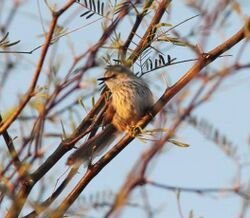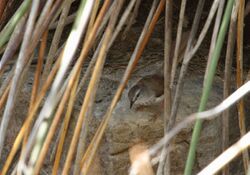Biology:Namaqua warbler
| Namaqua warbler | |
|---|---|

| |
| At Brandvlei, Northern Cape, South Africa | |
| Scientific classification | |
| Domain: | Eukaryota |
| Kingdom: | Animalia |
| Phylum: | Chordata |
| Class: | Aves |
| Order: | Passeriformes |
| Family: | Cisticolidae |
| Genus: | Phragmacia Brooke & Dean, 1990 |
| Species: | P. substriata
|
| Binomial name | |
| Phragmacia substriata (Smith, 1842)
| |
The Namaqua warbler (Phragmacia substriata), also known as the Namaqua prinia or white-breasted prinia, is a small passerine bird, a cisticolid warbler and the sole member of the genus Phragmacia. It was formerly placed in the genus Prinia, but was found to be sufficiently distinct to warrant a genus of its own.
Description
The Namaqua warbler is 12–13 cm long, with short rounded wings, a long tail, strong legs and a short straight black bill. The head has a whitish eyebrow and the upperparts are otherwise a rich russet brown. The throat and lower face are whitish with no streaking, and the breast is white with faint streaking. The rear flanks are buff. The long, brown tail is typically cocked up at an angle. The feet and legs are pinkish-brown, and the eye is brown. The sexes are identical, but juveniles are duller than the adults. The calls include a high-pitched treeep-treep-trrrrrr.
The Namaqua warbler can only be confused with the Karoo prinia, but that species has a shorter, less whispy tail, duller brown back and buff tips to the undertail feathers.
Distribution and habitat
This is a resident breeder in western South Africa and southern Namibia. It is a species endemic to the Karoo in thick bushes in dry river gullies and reedbeds near rivers and dams.
Behaviour
The warbler is usually seen in pairs or small groups, typically low in scrub, foraging for small insects, with tail cocked.
Conservation status
This common species has a large range, with an estimated extent of 380,000 km². The population size is believed to be large, and the species is not believed to approach the thresholds for the population decline criterion of the IUCN Red List (i.e. declining more than 30% in ten years or three generations). For these reasons, the species is evaluated as least concern.[1]
References
- ↑ 1.0 1.1 BirdLife International (2016). "Phragmacia substriata". IUCN Red List of Threatened Species 2016: e.T22713658A94385104. doi:10.2305/IUCN.UK.2016-3.RLTS.T22713658A94385104.en. https://www.iucnredlist.org/species/22713658/94385104. Retrieved 13 November 2021.
- Ian Sinclair, Phil Hockey and Warwick Tarboton, SASOL Birds of Southern Africa (Struik 2002) ISBN:1-86872-721-1
- Ryan, Peter (2006). Family Cisticolidae (Cisticolas and allies). pp. 378–492 in del Hoyo J., Elliott A. & Christie D.A. (2006) Handbook of the Birds of the World. Volume 11. Old World Flycatchers to Old World Warblers Lynx Edicions, Barcelona ISBN:978-84-96553-06-4
- Nguembock B.; Fjeldsa J.; Tillier A.; Pasquet E. (2007): A phylogeny for the Cisticolidae (Aves: Passeriformes) based on nuclear and mitochondrial DNA sequence data, and a re-interpretation of a unique nest-building specialization. Molecular Phylogenetics and Evolution 42: 272–286.
External links
- Namaqua warbler - Species text in The Atlas of Southern African Birds.
Wikidata ☰ Q1924540 entry
 |



